Role of Sugarcane Juice as a Natural Admixture on Setting Time and Hardened Properties of Cementitious Materials
Abstract
1. Introduction
2. Materials and Methods
2.1. Initial and Final Setting Time of Mortar Mixes
2.2. Fresh and Hardened Properties of Concrete
3. Results and Discussion
3.1. Effect of Sugarcane Juice on Setting Time of Cement Paste
3.2. Effect of Cement to Sand (c/s) and Water to Cement (w/c) Ratio in Setting Time of Mortar
3.3. Slump Value of Concrete with Different SCJ Content
3.4. Compressive and Splitting Tensile Strength of Concrete with Different SCJ Content
3.5. Statistical Analysis of the Effect of SCJ on the Strength of Concrete
4. Discussion
5. Conclusions
- The setting time was reduced with the increased SCJ content in the mix. As an accelerator, the minimum SCJ for cement mortar is 5% by water weight.
- The mix compositions also influenced the setting time of cement mortar. For the cement to sand ratio (c/s) of 1:1, the optimum water-to-cement ratio (w/c) is 0.30. This implies that the initial setting time of mortar reduces significantly at low c/s and w/c ratios. At c/s of 1:1.5 and 1:2, the optimum results can be obtained at w/c ratios of 0.40 and 0.50.
- The compressive strength of concrete increased as the SCJ content increased in the concrete mix. However, the compressive strength development at early curing age, such as at 7 days, is insignificant. The difference in strength was more pronounced at longer curing ages (14 and 28 days). In the case of splitting tensile strength, the differences in the strength were not so significant in SCJ mixed concrete compared to the control mix.
- The ANOVA proved that higher percentages of SCJ produced a compressive strength that was not statistically different from the control concrete mix (without SCJ). However, this trend is not valid for splitting tensile strength.
Author Contributions
Funding
Institutional Review Board Statement
Informed Consent Statement
Data Availability Statement
Acknowledgments
Conflicts of Interest
References
- Mohamed, A.K.; Weckwerth, S.A.; Mishra, R.K.; Heinz, H.; Flatt, R.J. Molecular modeling of chemical admixtures; opportunities and challenges. Cem. Concr. Res. 2022, 156, 106783. [Google Scholar] [CrossRef]
- Raju, T.; Ramaswamy, K.P.; Saraswathy, B. A review on the effects of chemical admixtures on alkali activated concrete. Mater. Today Proc. 2022, 65, 846–851. [Google Scholar] [CrossRef]
- Alexander, M. Fulton’s Concrete Technology, 10th ed.; Cement & Concrete SA: Midrand, South Africa, 2021. [Google Scholar]
- Khan, B.; Baradan, B. The effect of sugar on setting-time of various types of cements. Q. Sci. Vis. 2002, 8, 71–78. [Google Scholar]
- Khan, B.; Ullah, M. Effect of a retarding admixture on the setting time of cement pastes in hot weather. Eng. Sci. 2004, 15, 63–79. [Google Scholar]
- Al Khafaji, Z.S.; Ruddock, F. Study the retardant effect of using different sugar’s types on setting time and temperature of cement paste. Int. J. Civ. Eng. Technol. 2018, 9, 519–530. [Google Scholar]
- Ahmad, S.; Lawan, A.; Al-Osta, M. Effect of sugar dosage on setting time, microstructure and strength of Type I and Type V Portland cements. Case Stud. Constr. Mater. 2020, 13, e00364. [Google Scholar] [CrossRef]
- Thomas, N.L.; Birchall, J.D. The retarding action of sugars on cement hydration. Cem. Concr. Res. 1983, 13, 830–842. [Google Scholar] [CrossRef]
- Abalaka, A.E. Comparative effects of cassava starch and simple sugar in cement mortar and concrete. ATBU J. Sci. Technol. 2011, 4, 13–22. [Google Scholar]
- Young, J.F. A review of the mechanisms of set-retardation in Portland cement pastes containing organic admixtures. Cem. Concr. Res. 1972, 2, 415–433. [Google Scholar] [CrossRef]
- Erdoğan, T.Y. Admixtures for Concrete; Middle East Technical University: Ankara, Turkey, 1997; ISBN 975-479-113-6-188. [Google Scholar]
- Aïtcin, P.C. Accelerators. In Science and Technology of Concrete Admixtures, 1st ed.; Woodhead Publishing: Sawston, UK, 2016; pp. 405–413. [Google Scholar] [CrossRef]
- Kunchariyakun, K.; Sinyoung, S.; Kajitvichyanukul, P. Comparative microstructures and mechanical properties of mortar incorporating wood fiber waste from various curing conditions. Case Stud. Constr. Mater. 2022, 16, e00855. [Google Scholar] [CrossRef]
- Luo, B.; Luo, Z.; Wang, D.; Shen, C.; Xia, M. Influence of alkaline and alkali-free accelerators on strength, hydration and microstructure characteristics of ultra-high performance concrete. J. Mater. Res. Technol. 2021, 15, 3283–3295. [Google Scholar] [CrossRef]
- Su, Y.; Luo, B.; Luo, Z.; Huang, H.; Li, J.; Wang, D. Effect of accelerators on the workability, strength, and microstructure of ultra-high-performance concrete. Materials 2021, 15, 159. [Google Scholar] [CrossRef] [PubMed]
- Usman, N.D.; Chom, H.A.; Salisu, C.; Abubakar, H.O.; Gyang, J.B. The impact of sugar on setting-time of ordinary Portland cement (OPC) paste and compressive strength of concrete. FUTY J. Environ. 2016, 10, 107–114. [Google Scholar]
- Mahmood, H.F.; Dabbagh, H.; Mohammed, A.A. Comparative study on using chemical and natural admixtures (grape and mulberry extracts) for concrete. Case Stud. Constr. Mater. 2021, 15, e00699. [Google Scholar] [CrossRef]
- Hazarika, A.; Hazarika, I.; Gogoi, M.; Bora, S.S.; Borah, R.R.; Goutam, P.J.; Saikia, N. Use of a plant based polymeric material as a low cost chemical admixture in cement mortar and concrete preparations. J. Build. Eng. 2018, 15, 194–202. [Google Scholar] [CrossRef]
- Babu, T.R.; Neeraja, D. A experimental study of natural admixture effect on conventional concrete and high volume class F fly ash blended concrete. Case Stud. Constr. Mater. 2017, 6, 43–62. [Google Scholar]
- Ekop, I.E.; Harry, O.A. Influence of Dracaena Aborea and Carica Papaya Leave Extracts on the Strength and Setting Time of Cement Paste and Mortar. IOSR j. Mech. Civ. Eng. (IOSR-JMCE) 2020, 17, 17–20. [Google Scholar]
- Otunyo, A.W.; Koate, I. Sugar cane juice as a retarding admixture in concrete production. Glob. J. Eng. Res. 2015, 14, 17–23. [Google Scholar] [CrossRef]
- Maraveas, C. Production of sustainable and biodegradable polymers from agricultural waste. Polymers 2020, 12, 1127. [Google Scholar] [CrossRef]
- Rosso, F.; Pisello, A.L.; Pigliautile, I.; Cavalaglio, G.; Coccia, V. Natural, bio-based, colored linoleum: Design, preparation, characteristics and preliminary life cycle assessment. J. Clean. Prod. 2020, 267, 122202. [Google Scholar] [CrossRef]
- Huang, H.; Yuan, Q.; Deng, D.; Peng, J.; Huang, Y. Effects of chemical and mineral admixtures on the foam indexes of cement-based materials. Case Stud. Constr. Mater. 2019, 11, e00232. [Google Scholar] [CrossRef]
- Azevedo, A.R.; Marvila, M.T.; Zanelato, E.B.; Alexandre, J.; Xavier, G.C.; Cecchin, D. Development of mortar for laying and coating with pineapple fibers. Rev. Bras. Eng. Agricola Ambient 2020, 24, 187–193. [Google Scholar] [CrossRef]
- Khorasani, F.F.; Kabir, M.Z. Experimental study on the effectiveness of short fiber reinforced clay mortars and plasters on the mechanical behavior of adobe masonry walls. Case Stud. Constr. Mater. 2022, 16, e00918. [Google Scholar] [CrossRef]
- ASTM C191-21; Standard Test Method for Time of Setting of Hydraulic Cement by Vicat Needle. ASTM International: West Conshohocken, PA, USA, 2021.
- Arefin, M.S.; Rahman, M.M.; Alim, M.A. Physico-chemical properties of goor and quality of sugarcane (Saccharum officinarum) as influenced by integrated nutrient management in Bangladesh. MOJ Ecol. Environ. Sci. 2020, 5, 271–278. [Google Scholar] [CrossRef]
- Miah, M.J.; Ali, M.K.; Paul, S.C.; John Babafemi, A.; Kong, S.Y.; Šavija, B. Effect of recycled iron powder as fine aggregate on the mechanical, durability, and high temperature behavior of mortars. Materials 2020, 13, 1168. [Google Scholar] [CrossRef]
- ASTM C143/C143M-12; Standard Test Method for Slump of Hydraulic-Cement Concrete. ASTM International: West Conshohocken, PA, USA, 2012. [CrossRef]
- ASTM C39/C39M-14; Standard Test Method for Compressive Strength of Cylindrical Concrete Specimens. ASTM International: West Conshohocken, PA, USA, 2014. [CrossRef]
- ASTM C496-96; Standard Test Method for Splitting Tensile Strength of Cylindrical Concrete Specimens. ASTM International: West Conshohocken, PA, USA, 1996. [CrossRef]
- Shetty, M.S.; Jain, A.K. Concrete Technology (Theory and Practice), 8th ed.; S. Chand Publishing: New Delhi, India, 2019. [Google Scholar]
- Juenger, M.C.G.; Jennings, H.M. New insights into the effects of sugar on the hydration and microstructure of cement pastes. Cem. Concr. Res. 2002, 32, 393–399. [Google Scholar] [CrossRef]
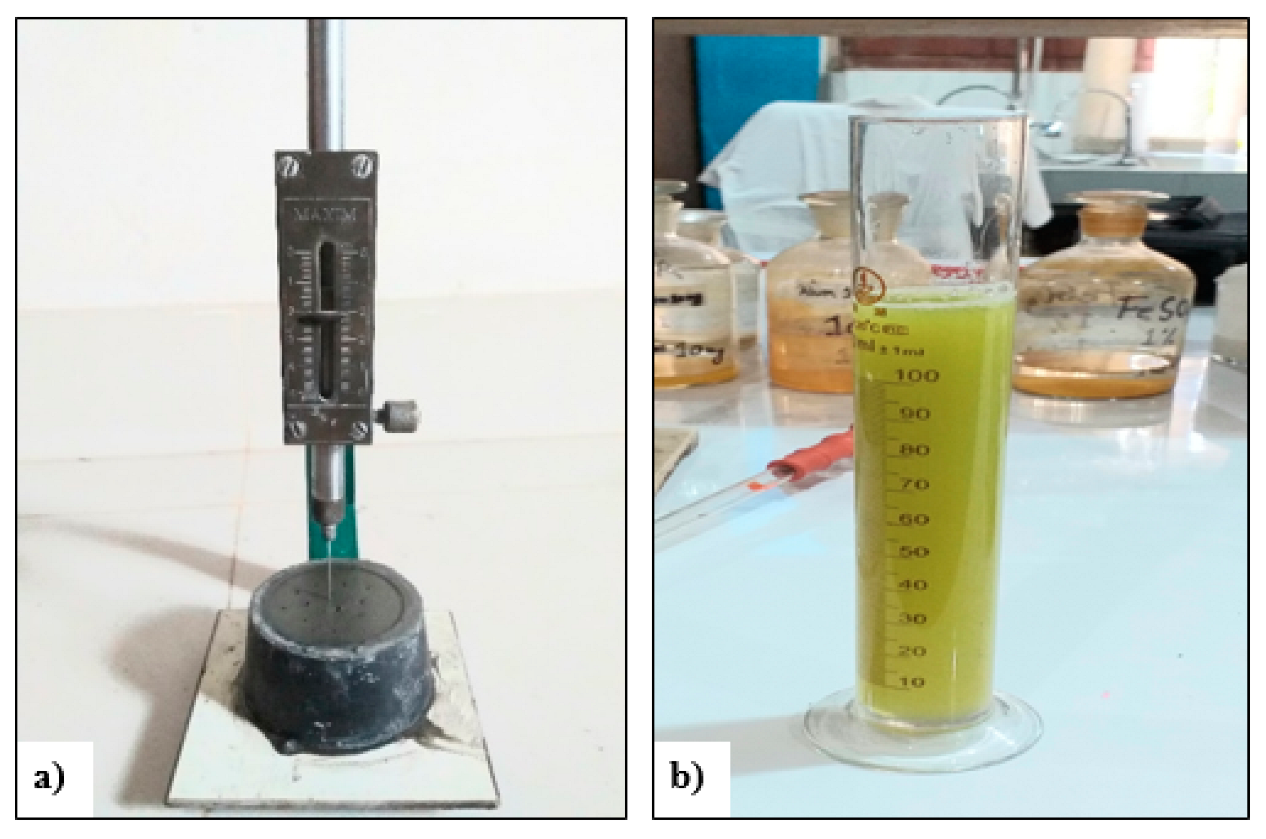

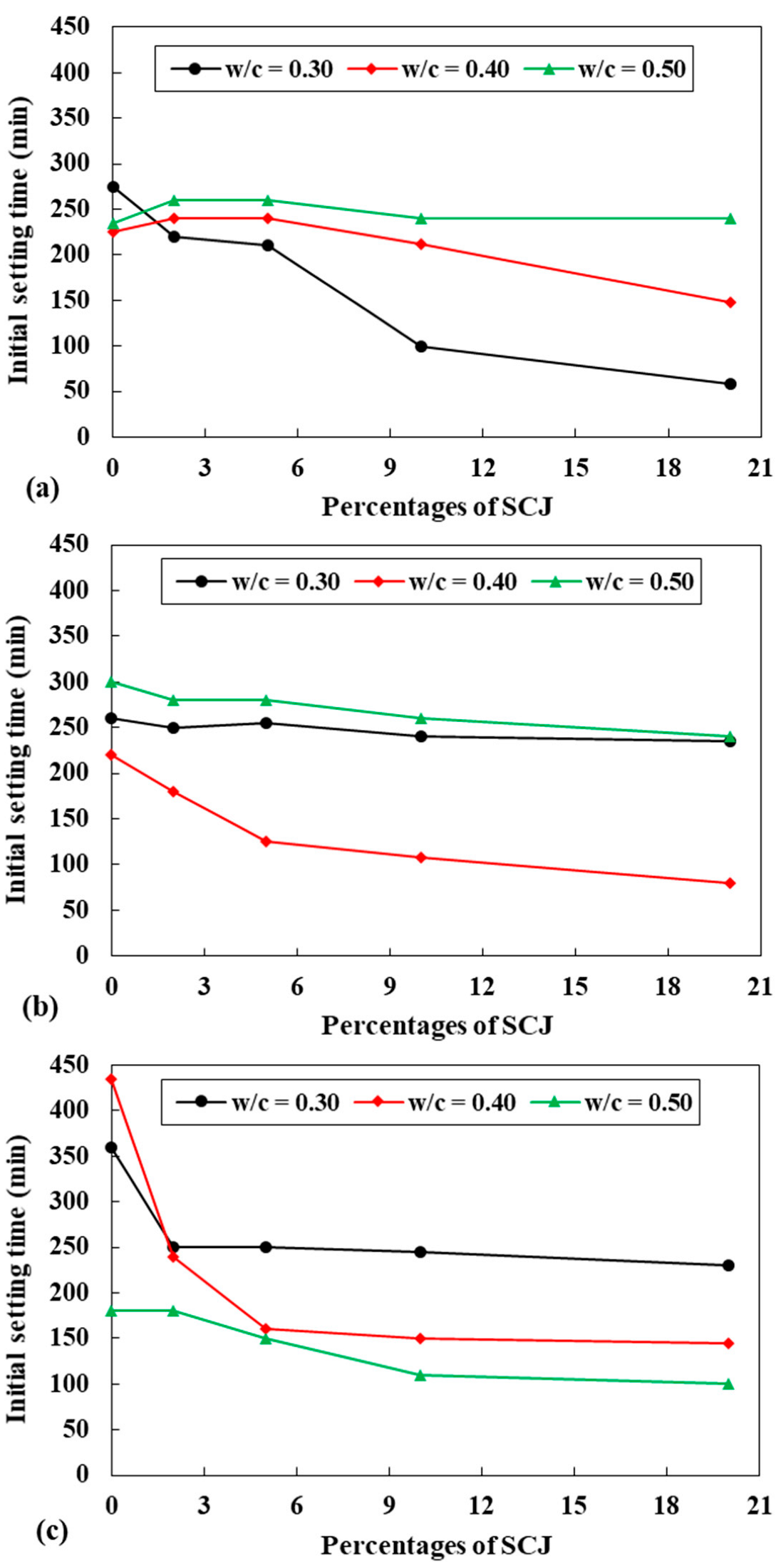

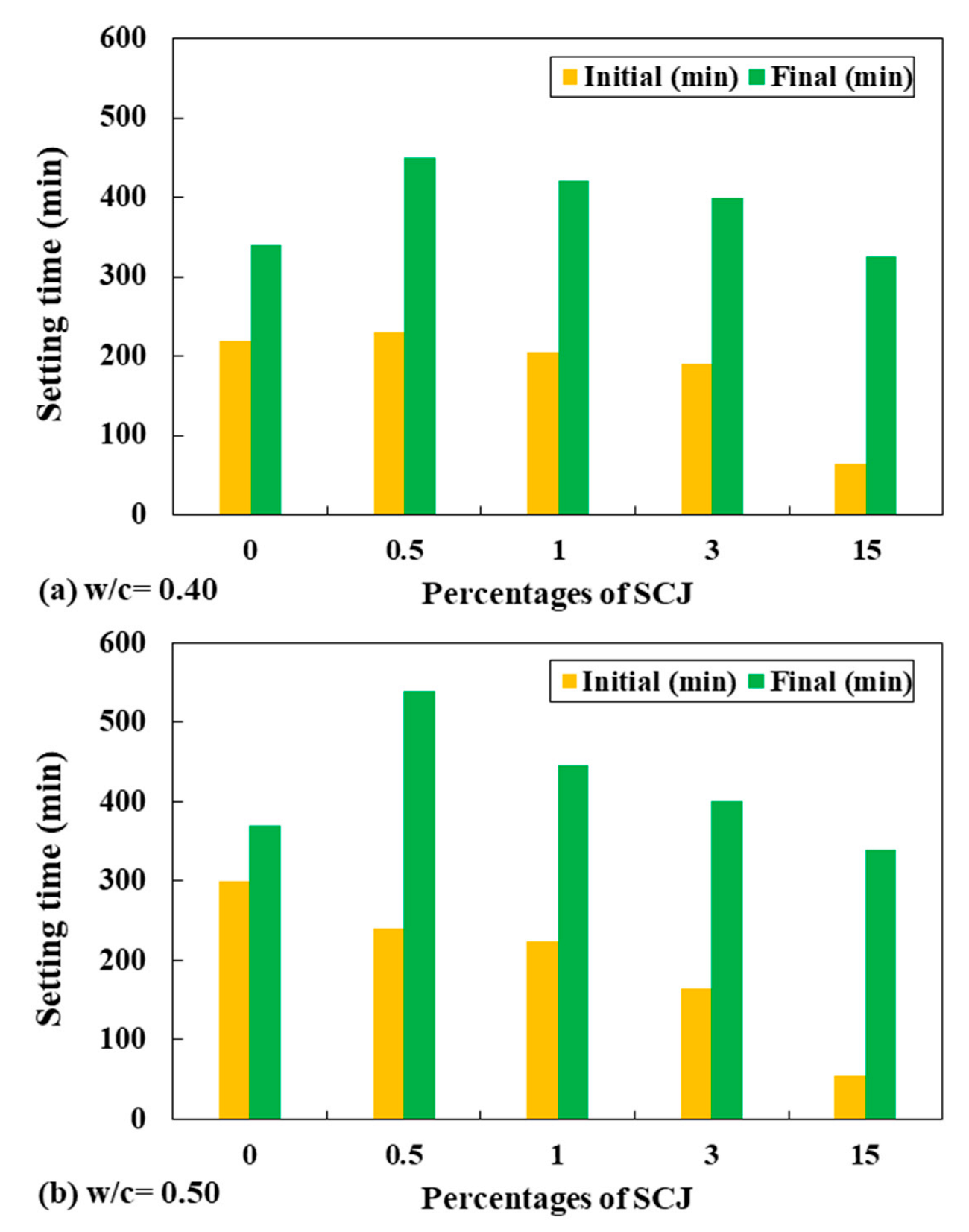
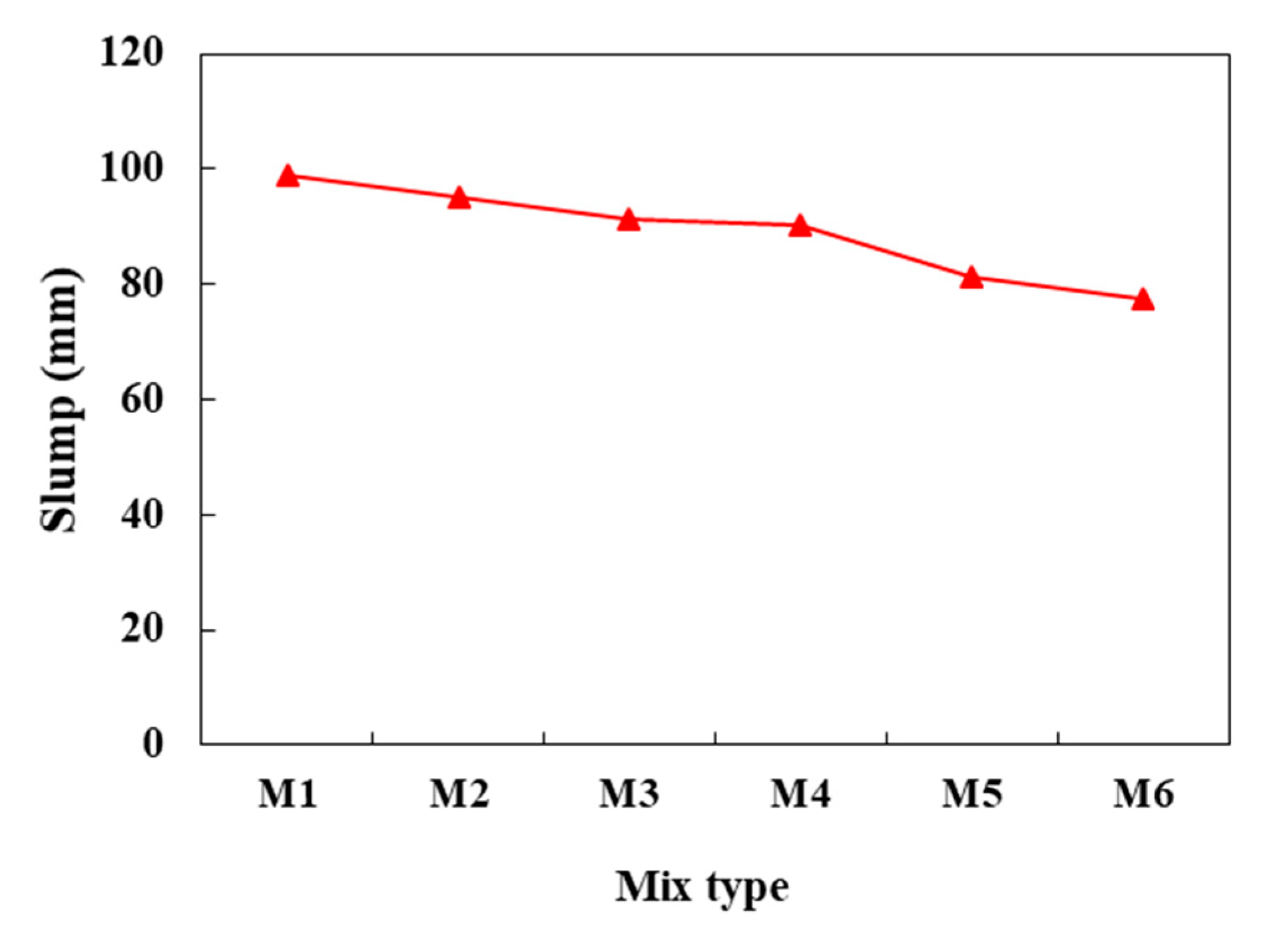
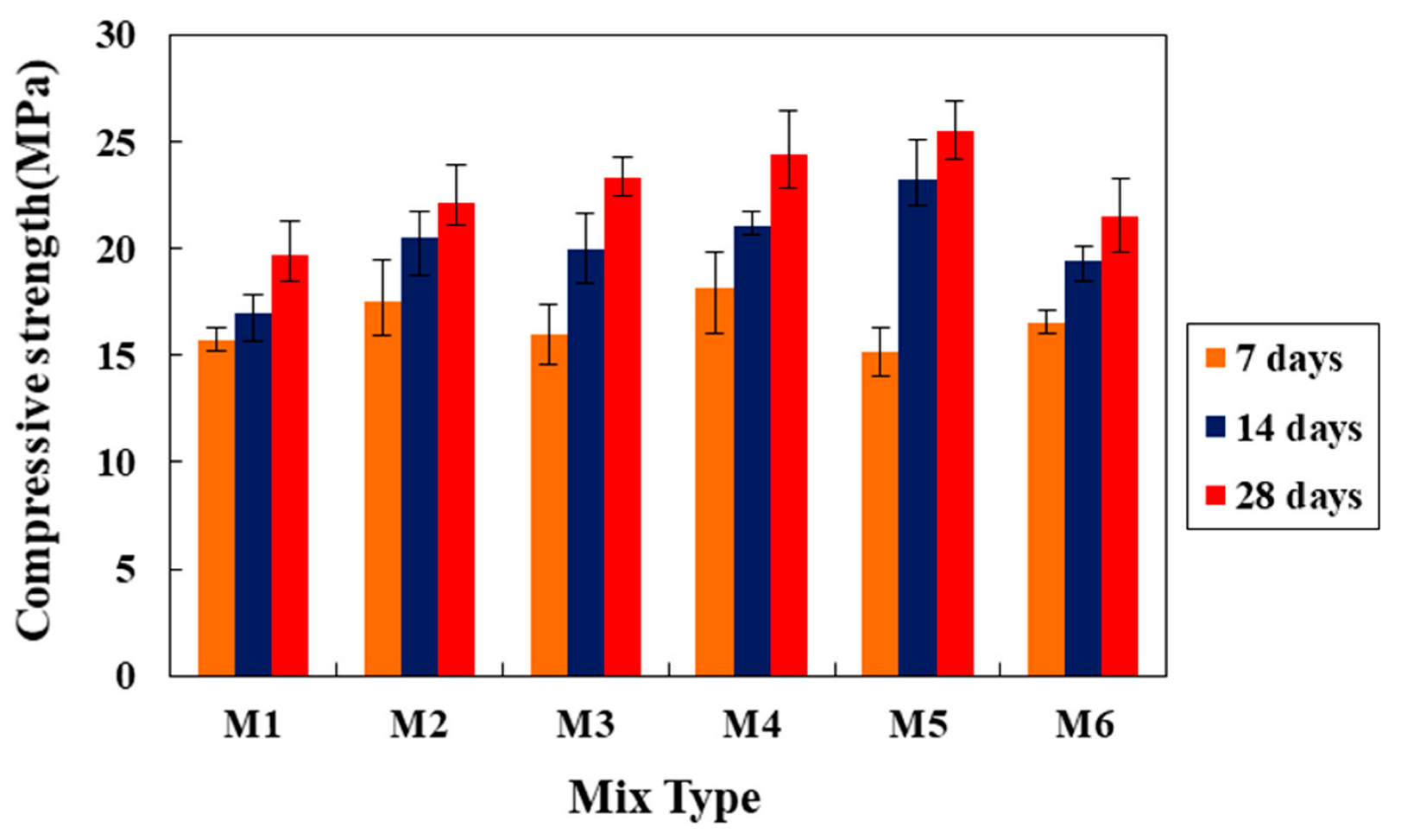
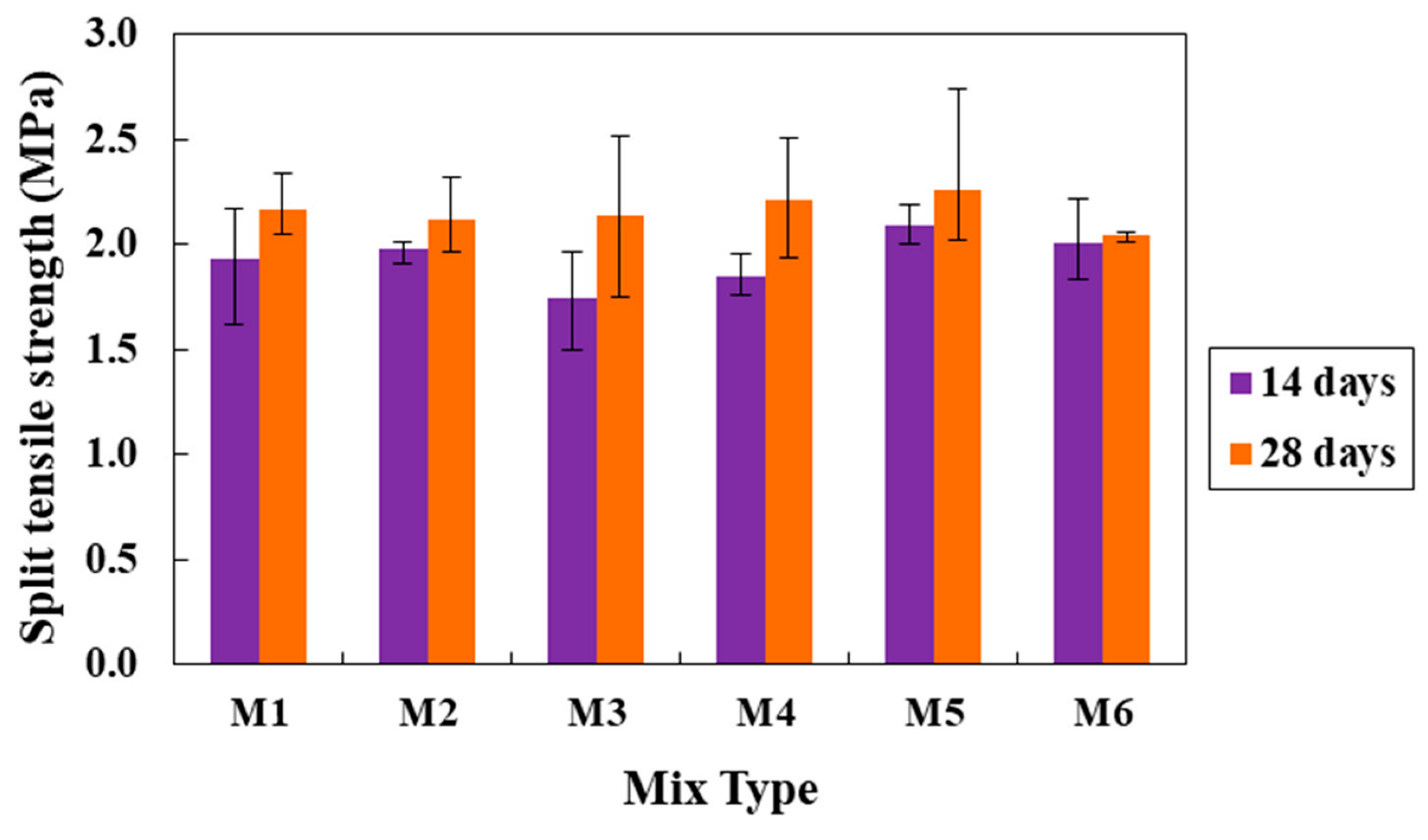
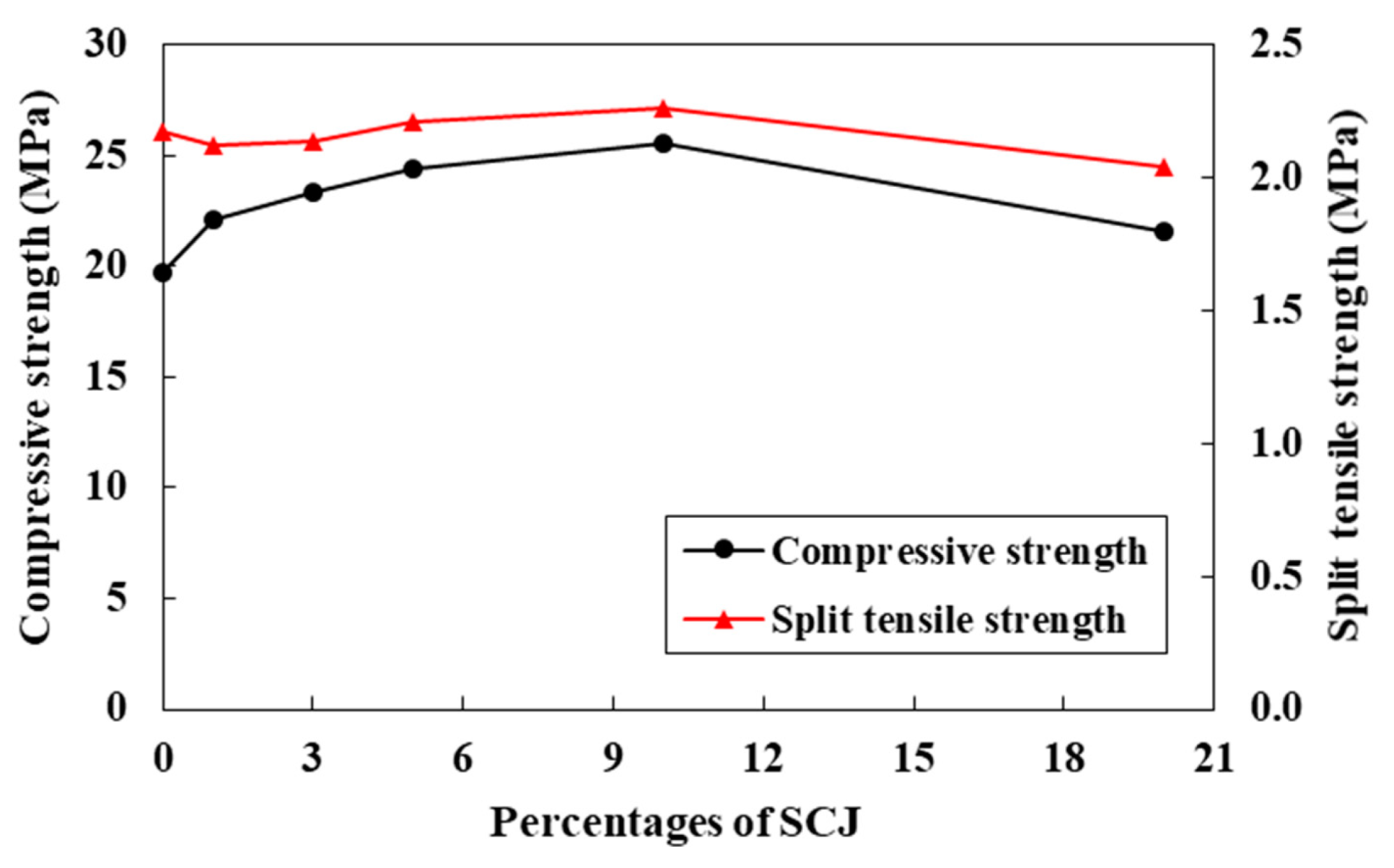
| Cement to sand Ratio (c/s) | Water to Cement Ratio (w/c) | Sugarcane Juice (SCJ) (% by Water Weight) |
|---|---|---|
| 1:1 | 0.30 | 0, 2, 5, 10, 20 |
| 0.40 | 0, 2, 5, 10, 20 | |
| 0.50 | 0, 2, 5, 10, 20 | |
| 1:1.5 | 0.30 | 0, 0.5, 1, 3, 2, 5, 10, 15, 20 |
| 0.40 | 0, 2, 5, 10, 20 | |
| 0.50 | 0, 0.5, 1, 3, 2, 5, 10, 15, 20 | |
| 1:2 | 0.30 | 0, 2, 5, 10, 20 |
| 0.40 | 0, 2, 5, 10, 20 | |
| 0.50 | 0, 2, 5, 10, 20 |
| Mix ID | SCJ (%) | Cement | Water | Fine Aggregates | Coarse Aggregates | Plasticizer |
|---|---|---|---|---|---|---|
| M1 | 0 | 452 | 153.33 | 680 | 1019 | 6.67 |
| M2 | 1 | 452 | 152.34 | 680 | 1019 | 6.06 |
| M3 | 3 | 452 | 149.7 | 680 | 1019 | 5.5 |
| M4 | 5 | 452 | 147.79 | 680 | 1019 | 4.21 |
| M5 | 10 | 452 | 144 | 680 | 1019 | 0 |
| M6 | 20 | 452 | 128 | 680 | 1019 | 0 |
| Groups | Source of Variation | Degree of Freedom | Sum of Squares | Mean Square | F-Test | p-Value | Significance |
|---|---|---|---|---|---|---|---|
| Compressive strength at 14 and 28 days | Between groups | 1 | 17.93 | 17.93 | 3.56 | 0.096 | No |
| Within groups | 8 | 40.30 | 5.04 | ||||
| Splitting tensile strength at 14 and 28 days | Between groups | 1 | 0.17 | 0.17 | 16.52 | 0.0036 | Yes |
| Within groups | 8 | 0.082 | 0.010 |
Publisher’s Note: MDPI stays neutral with regard to jurisdictional claims in published maps and institutional affiliations. |
© 2022 by the authors. Licensee MDPI, Basel, Switzerland. This article is an open access article distributed under the terms and conditions of the Creative Commons Attribution (CC BY) license (https://creativecommons.org/licenses/by/4.0/).
Share and Cite
Paul, S.C.; Babafemi, A.J.; Miah, M.J.; Basit, M.A.; Hasan, N.M.S.; Kong, S.Y. Role of Sugarcane Juice as a Natural Admixture on Setting Time and Hardened Properties of Cementitious Materials. Infrastructures 2022, 7, 145. https://doi.org/10.3390/infrastructures7100145
Paul SC, Babafemi AJ, Miah MJ, Basit MA, Hasan NMS, Kong SY. Role of Sugarcane Juice as a Natural Admixture on Setting Time and Hardened Properties of Cementitious Materials. Infrastructures. 2022; 7(10):145. https://doi.org/10.3390/infrastructures7100145
Chicago/Turabian StylePaul, Suvash Chandra, Adewumi John Babafemi, Md Jihad Miah, Md Abdul Basit, Noor Md. Sadiqul Hasan, and Sih Ying Kong. 2022. "Role of Sugarcane Juice as a Natural Admixture on Setting Time and Hardened Properties of Cementitious Materials" Infrastructures 7, no. 10: 145. https://doi.org/10.3390/infrastructures7100145
APA StylePaul, S. C., Babafemi, A. J., Miah, M. J., Basit, M. A., Hasan, N. M. S., & Kong, S. Y. (2022). Role of Sugarcane Juice as a Natural Admixture on Setting Time and Hardened Properties of Cementitious Materials. Infrastructures, 7(10), 145. https://doi.org/10.3390/infrastructures7100145










